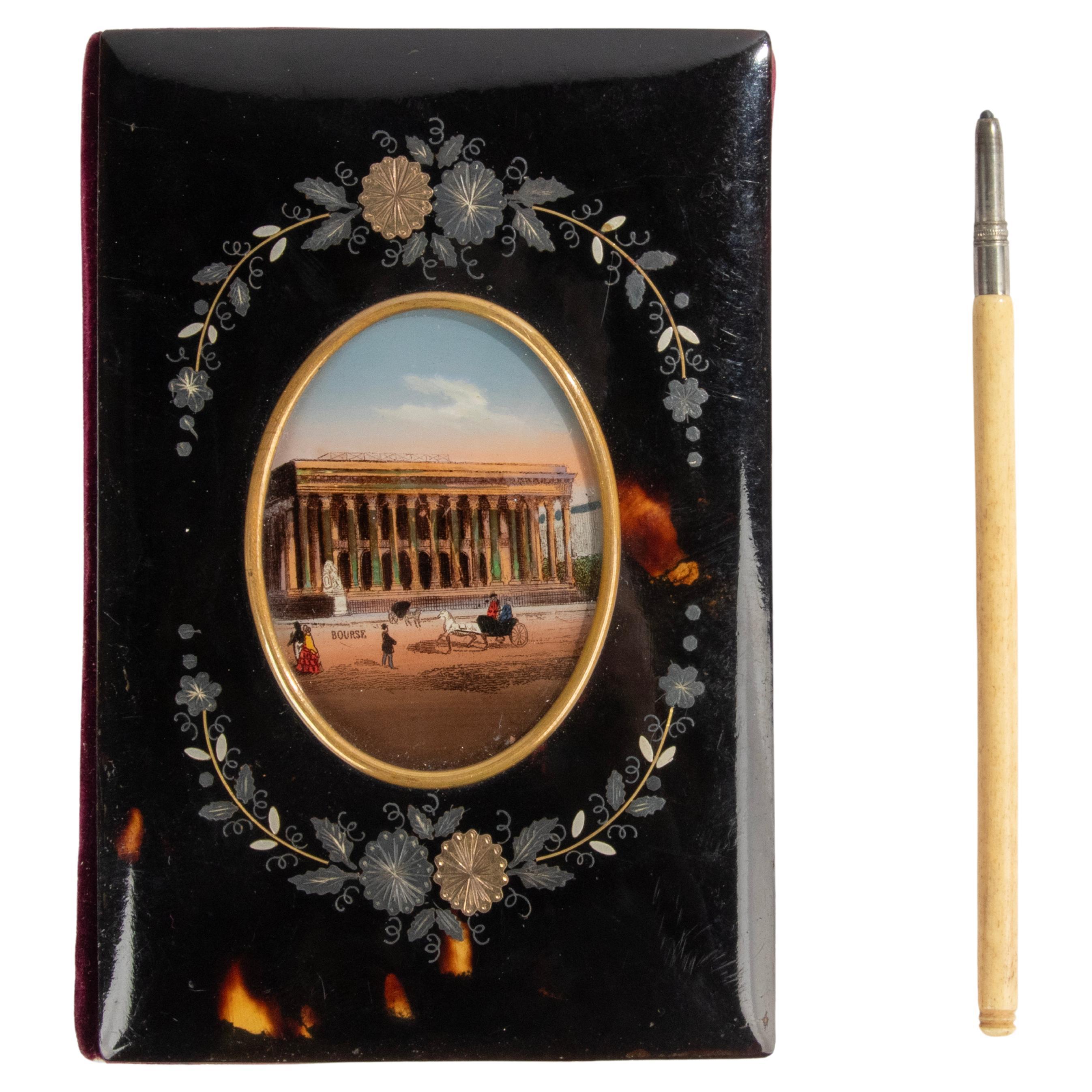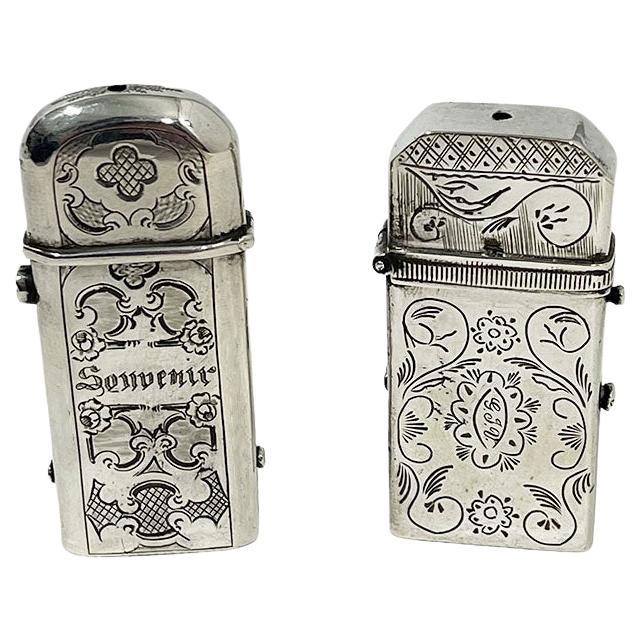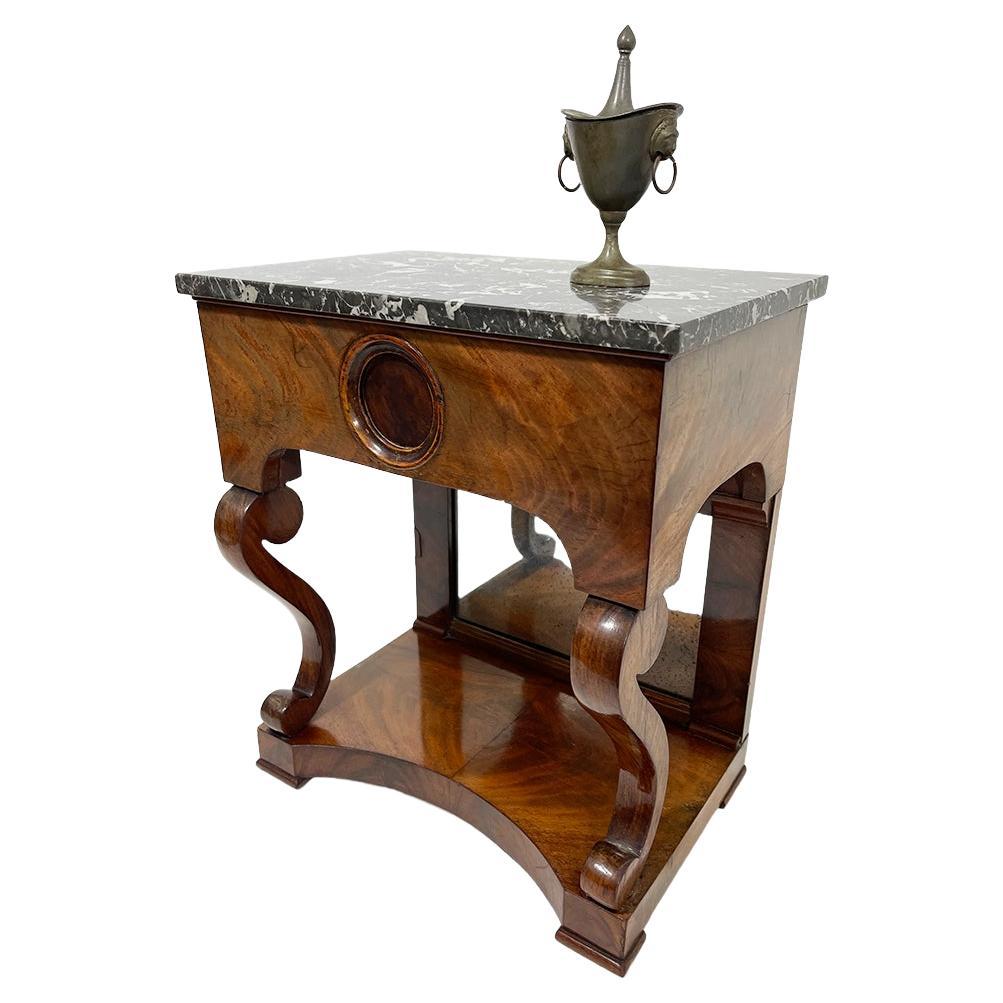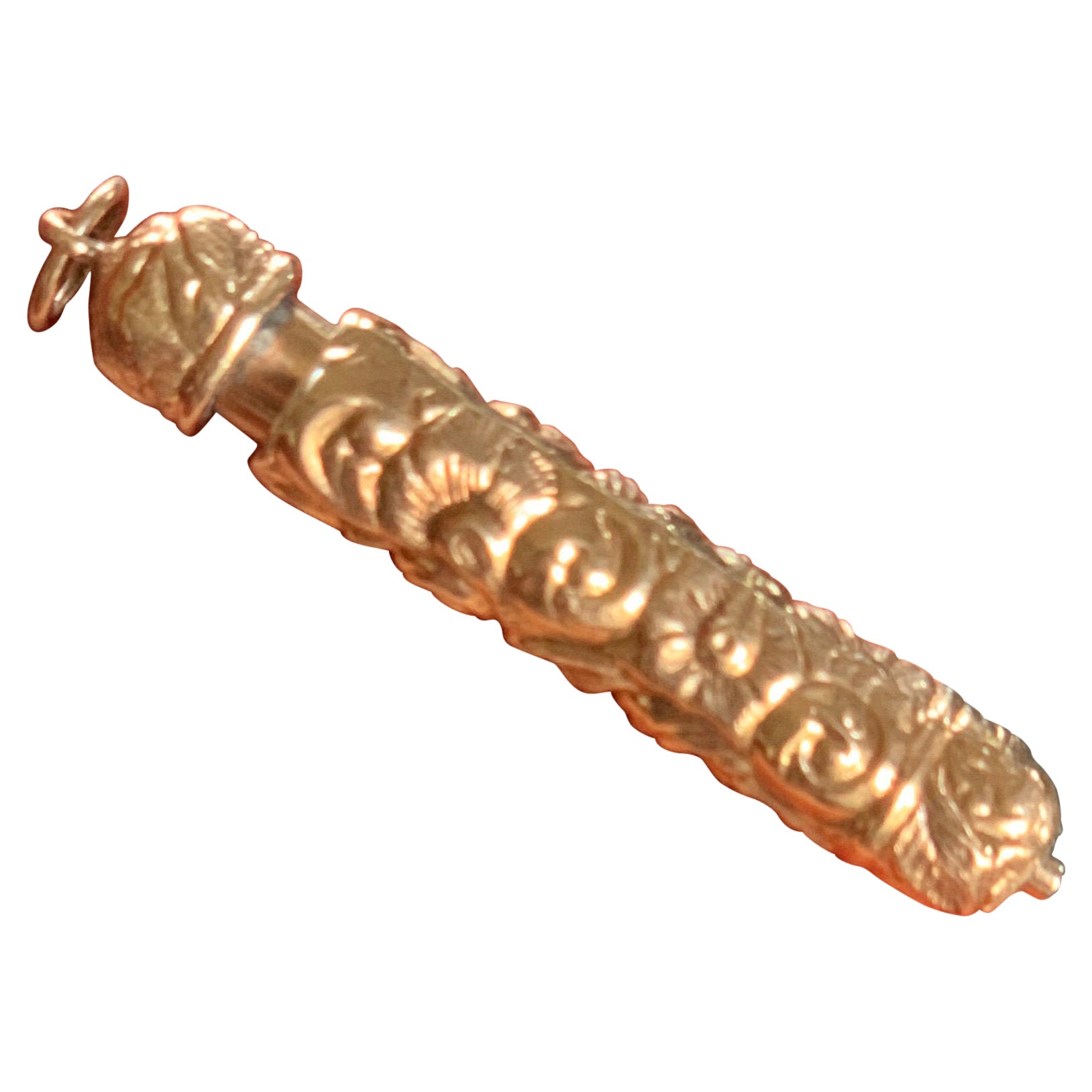Items Similar to Dutch 19th Century gold sliding pencil
Want more images or videos?
Request additional images or videos from the seller
1 of 5
Dutch 19th Century gold sliding pencil
About the Item
Dutch 19th Century gold sliding pencil
A Dutch gold pencil holder in a ribbed motif with a sliding system. These pencil holders are usually made as pendants. This gold pencil holder is Dutch hallmarked with the "Clover" which was used during 1853-1906. It is 14 carat gold (583/1000) It is hallmarked underneath in the rib of the pencil holder as well as in the band, which you use to shift the pencil.
The measurement is with eyelet 7.5 cm long and 0.7 cm diagonal.
The total weight including the pencil is 8 grams
- Dimensions:Height: 2.96 in (7.5 cm)Diameter: 0.28 in (7 mm)
- Materials and Techniques:
- Place of Origin:
- Period:
- Date of Manufacture:19th Century
- Condition:Wear consistent with age and use.
- Seller Location:Delft, NL
- Reference Number:
About the Seller
5.0
Platinum Seller
These expertly vetted sellers are 1stDibs' most experienced sellers and are rated highest by our customers.
Established in 1995
1stDibs seller since 2018
312 sales on 1stDibs
Typical response time: <1 hour
- ShippingRetrieving quote...Ships From: Delft, Netherlands
- Return PolicyA return for this item may be initiated within 7 days of delivery.
More From This SellerView All
- Dutch 19th Century Carved Wooden BarometerLocated in Delft, NLA Dutch carved wooden barometer with copper and facet cut glass housing. The carved wood has a scene of fruits and scrolls A barometer is a scien...Category
Antique Late 19th Century Dutch Scientific Instruments
MaterialsWood
- 2 Dutch Silver Match Vestas, 19th CenturyLocated in Delft, NL2 Dutch Silver Match Vestas, 19th Century 2 Silver match vestas, Dutch silver, Silver Hallmarked with the "Sword" used from 1814-1906. The one with the te...Category
Antique 19th Century Dutch Tobacco Accessories
MaterialsSilver
- A Dutch 19th Century Miniature Console tableLocated in Delft, NLA Dutch 19th Century Miniature Console table A 19th Century Dutch console table of 38 cm high with marble top, which is loose on the table. With an antique mirror and curled legs. An antique miniature pewter chestnut pot with lion heads...Category
Antique 19th Century Dutch Toys and Dolls
MaterialsMarble
- 19th Century Dutch Silver Pipe Stopper with ShipLocated in Delft, NLA 19th century Dutch silver pipe stopper with ship. A ship on a plateau on the stem. The stem is openwork and twisted. The pipe cleaner was originally a simple instrument only intended to empty the pipe bowl. 19th Century and Dutch hallmarked with the "Sword" used from 1814-1906. The silversmith mark is faded The size of the pipe cleaner is 10,5 cm high, 2 cm wide and the depth is 0,7 cm ( 4.1 Inch x 0.8 Inch x 0.3 Inch) The weight is 14 grams The silver version of the pipe cleaner, consisting of a pen topped by a figure, has no relation to the luxurious multi-piece garnish or the clipping tube. It originated from the simple brass or copper predecessor or the more popular variant of wood, bone or in a rare case also ivory. It is a consumable with only one purpose: to remove the tobacco plug at the bottom of the pipe bowl and to clean the kettle. The point is the working part of the object, the decorative element functions as a handle. In addition to the pipe stopper intended for pressing the smoldering tobacco, the rooting tool is an indispensable tool for the smoker to empty the pipe bowl after smoking. Strangely enough, there is little relationship between the pipe stopper on the one hand and the pipe rooter on the other. It is especially remarkable that the silver rooters...Category
Antique 19th Century Dutch Tobacco Accessories
MaterialsSilver
- Dutch 19th Century Crystal and Gold Scent, Perfume Bottle, Ca 1860Located in Delft, NLA Dutch 19th century crystal and gold scent, perfume bottle, ca 1860 A Dutch scent or perfume bottle with crystal cut shaped body and gold (14 Carat, 585...Category
Antique 19th Century Dutch Bottles
MaterialsCrystal, Gold
- Dutch 19th Century Silver Chatelaine with 4 Cachets and CharmsLocated in Delft, NLDutch 19th century silver chatelaine with 4 cachets and charms Silver chatelaine with 4 cachets and charms. The charms are a very small miniature knife...Category
Antique Late 19th Century Dutch Collectible Jewelry
MaterialsSilver
You May Also Like
- Little 19th Century Notebook with PencilLocated in Casteren, Noord-BrabantA small antique notebook. At the front cover is a hand painted medallion depicting the Palais Bourse building, the Paris stock exchange. Surrounded wi...Category
Antique 1880s French Napoleon III Books
MaterialsFabric, Paper
- 19th Century Dutch Miniature Secretaire CabinetLocated in Casteren, NL19th century miniature secretaire cabinet made from Oakwood. Decorative object, can be used as jewelry/letter box. Originates Netherlands, dating, circa 1800Category
Antique Early 19th Century Dutch Models and Miniatures
MaterialsOak
- 19th Century French Tiny Pencil Case in Gold Chiseled with FlowersLocated in Sofia, BGSmall pencil case in gold, chiseled with flowers. Late 19th century - early 20th century May be used as a pendant as well. Gross weight: 8.77 gr Small shocks France, circa 1900.Category
Early 20th Century French Collectible Jewelry
MaterialsGold
- Rare 19th Century English Tunbridgeware Hair Pin or SlideLocated in Dallas, TXPresenting an absolutely gorgeous and extremely unique and rare 19th century British Tunbridgeware hair pin/bobbin or slide. This slide is unlike any of it’s kind we have seen before…. it is a very rare survivor ! From circa 1860–1880. Made of walnut with gorgeous marquetry inlay on the entirety of the front with classic Tunbridgeware micro-mosaic all over the front. The rear is walnut. The marquetry inlay appears to be various different woods, namely, maple, walnut and satinwood. Would have been worn in a Lady’s hair bun with the micro-mosaic facing forward. This would have belonged to a very elegant lady in the mid to late 19th century. Tunbridge ware is a form of decoratively inlaid woodwork, typically in the form of boxes, that is characteristic of Tonbridge and the spa town of Royal Tunbridge Wells in Kent in the 18th and 19th centuries. The decoration typically consists of a mosaic of many very small pieces of different coloured woods that form a pictorial vignette. Shaped rods and slivers of wood were first carefully glued together, then cut into many thin slices of identical pictorial veneer with a fine saw. Elaborately striped and feathered bandings for framing were pre-formed in a similar fashion. There is a collection of Tunbridge ware in the Tunbridge Wells Museum and Art Gallery in Tunbridge Wells. The famous makers of Tunbridge ware were in the Tunbridge Wells area of Kent; their most notable work was from circa 1830-1900. Early makers of Tunbridge ware, in Tunbridge Wells in the mid-18th century, were the Burrows family, and Fenner and Co. In the 19th century, around 1830, James Burrows invented a technique of creating mosaics from wooden tesserae. Henry Hollamby, apprenticed to the Burrows family, set up on his own in 1842 and became an important manufacturer of Tunbridge ware, employing about 40 people. Edmund Nye (1797–1863) and his father took over the Fenner company when William Fenner retired in 1840, after 30 years in partnership with him. Thomas Barton (1819–1903), previously apprenticed at the Wise factory, joined the Nyes in 1836, and worked as Nye’s designer; he took over the business in 1863 and continued there until his death. In Tonbridge (near to Tunbridge Wells), George Wise (1703–1779) is known to have had a business in 1746. It continued with his son Thomas, and Thomas’s nephew George (1779–1869), who took over in 1806. In its early years the company made articles such as workboxes and tea caddies with prints of popular views; later items had pictures created from mosaics. Their workshop in Tonbridge, Wise’s Tunbridge Ware Manufactory, was next to the Big Bridge over the Medway; the building was demolished in 1886 to widen the approach to the bridge. Tunbridge ware became popular with visitors to the spa town of Tunbridge Wells, who bought them as souvenirs and gifts. Articles included cribbage boards, paperweights, writing slopes, snuffboxes and glove boxes. At the Great Exhibition of 1851, Tunbridge ware by Edmund Nye, Robert Russell and Henry Hollamby was shown; Edmund Nye received a commendation from the judges for his work. He exhibited a table depicting a mosaic of a ship at sea; 110,800 tesserae were used in making the picture. The manufacturers of Tunbridge ware were cottage industries, and they were no more than nine in Tunbridge Wells and one in Tonbridge. The number declined in the 1880s; competent craftsmen were hard to find, and public tastes changed. After the death of Thomas Barton in 1903 the only surviving firm was Boyce, Brown and Kemp, which closed in 1927. Marquetry was an old technique which was continued by Nye and Barton to create images such as birds or butterflies. ‘Green Oak’ as caused by the fungus Chlorociboria aeruginascens. Stickware and half-square mosaic was invented by James Burrows in about 1830: a bunch of wooden sticks of different colours, each having triangular or diamond-shaped cross section, were tightly glued together; in the case of stickware, the resulting block was dried, then turned to form an article such as the base of a pincushion. For half-square mosaic, thin slices were taken from the composite block, and applied to a surface.[1][2][4] Tesselated mosaic, was a development by James Burrows of half-square mosaic; it was adopted by George Wise and Edmund Nye. Minute tesserae were used to form a wide variety of geometric and pictorial designs. Many sorts of wood were used for the various colours; about 40 were in regular use. Only natural colors were used; green was provided by “green oak”, produced by the action of fungus on fallen oak. Designs for articles were often taken from designs of Berlin wool work.Category
Antique Late 19th Century English High Victorian Collectible Jewelry
MaterialsSatinwood, Walnut
- Clothing Press in Oak Wood, Holland, 19th CenturyLocated in Madrid, ESClothing press in oak wood, Holland, 19th century. Garment press with closed cupboard in its lower part made of oak wood in Holland. As is normal in these utilitarian elements, it la...Category
Antique 19th Century Dutch Neoclassical Historical Memorabilia
MaterialsMetal
- Clothing Press in Oak Wood, Holland, 19th CenturyLocated in Madrid, ESClothing press in oakwood, Holland, 19th century. On four turned legs (three of them secured with a straight chambrana) the press rises, with a drawer underneath. As it is a purely u...Category
Antique 19th Century Dutch Neoclassical Historical Memorabilia
MaterialsOak





